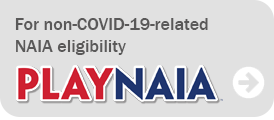Legislation FAQs
IMPORTANT: Unless otherwise noted in the below FAQs all normal eligibility rules must be met for students to be eligible to compete.
FALL 2020 ELIGIBILITY UPDATES (Added 8/12/2020)
A student can only be charged one SOC during any 12-month period. Because the NAIA season of competition often becomes a de-facto “umbrella” under which other competition can occur without harm, this year’s uncertainty of if or to what extent a given sport will be played at any individual NAIA institution effectively undermines a student-athlete’s ability to accurately budget thr competition.
SPRING 2020 SPORT ELIGIBILITY
Q: Are fall or winter sports from the 2019-2020 academic year getting any eligibility extensions or exceptions? (Added 4/3/2020)
ENTERING FRESHMAN
A student that does not have a satisfactory test score can satisfy freshman eligibility standards and become eligible by having at least a 2.000 final high school GPA. The student will receive an eligible determination from the eligibility center. However, any student using this exception will be required to earn at least a 2.000 cumulative collegiate GPA prior to their next season of competition in order to maintain eligibility and compete in that following season. This additional collegiate GPA requirement is required as part of the student’s ability to gain eligibility immediately by use of solely a high school GPA, and is in addition to any applicable continuing eligibility rules that would normally apply.
The 2.000 cumulative GPA that is required prior to the student’s next season of competition will be sport specific. For example, a student who becomes eligible in cross country based off of this initial eligibility exception will not be required to have a 2.000 cumulative collegiate GPA prior to indoor or outdoor track and field in 2020-21. Rather, the student will be required to meet the collegiate 2.000 cumulative GPA prior to their second cross country season of competition. Institutions will verify satisfaction of the college GPA requirement within the ECP software.
All 2020-2021 entering freshmen can still become eligible by satisfying two out of the three requirements, as normal. Any freshmen gaining eligibility this way will not be required to meet a collegiate 2.00 GPA prior to their second season of competition.
For example, a student could gain eligibility as a freshman by earning 9 institutional credit hours and having a 2.000 high school GPA. In that scenario, the student would not be required to utilize the COVID-19 freshman exception, and would not be required to earn a collegiate 2.00 GPA prior to their second season of competition.
The student could also gain eligibility as a freshman by earning 9 institutional credit hours and a satisfactory ACT or SAT test score.
Letter of Intent (added 8/12/2020)
TRANSFER STUDENTS
Transfer 16-week residency (added 8/12/2020)
SENIORS AND GRADUATE STUDENTS - Spring 2020
- Fall 2020: two (2) most recent TOAs are undergraduate = 24 undergrad hours required
- Spring 2021: one (1) most recent TOA is undergraduate, 1 is graduate = 12 undergrad hours + 9 graduate hours required
GENERAL ELIGIBILITY
A: The Competitive Experience Form is generally required when students have breaks in enrollment and/or are not charged seasons of competition. Recognizing that all spring 2020 student-athletes would meet the latter, it is not necessary for schools to fill out the form for spring-sport student-athletes based on 2019-20 enrollment or competition. The Competitive Experience Form will only be required for those spring-sport student-athletes who would meet the criteria for the form (see below) prior to May 16, 2019.
The Competitive Experience Form should be completed for any student who meets any of the following criteria since from the time of his or her Eligibility Center determination through May 16, 2019:
- NAIA Identification: Student was identified at an NAIA institution but not certified as eligible for one or more academic terms.
- Non-NAIA Identification: Student is transferring from a non-NAIA institution and was not charged a season of competition for every year in which student was enrolled full-time at a non-NAIA institution. If a student was not charged a season of competition during each year that the student was enrolled full-time at a non-NAIA institution, the student’s non-collegiate participation in that year(s) is subject to a competitive experience review.
- No Identification: Student has a break in continuous, full-time enrollment from any institution.
FINANCIAL ASSISTANCE
FINANCIAL AID AND MAXIMUM TEAM LIMITS
Q: Are we expected to report financial aid that we awarded to spring sport athletes, even though none of them are charged a season of competition? (Added 4/3/2020)
As it relates to financial aid limits, generally any aid like this that is provided by your institution would meet the definition of countable aid. However, Article II, Section B, Item 1b specifically states that such aid should “not discriminate for or against presumed or recognized athletes,” meaning that institutions should be able to distribute such funds to student-athletes without negative implication. Therefore, financial benefits allocated to student-athletes through financial support such as the CARES Act and that are available to athletes and non-athletes alike will not count as countable aid and will not accumulate towards a team’s maximum upper limit.
RECRUITING AND PRACTICE RULES
TRYOUTS
Q: Can multiple potential student-athletes tryout at the same time? (Added 6/25/2020)
Q: What would happen if a current student-athlete participated in a tryout with a prospective student-athlete on July 1, 2020? (Added 6/25/2020)
Q: Where can tryouts be conducted? (Added 6/25/2020)



